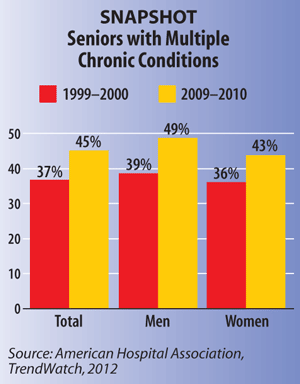Senior Chronic Disease Rates Climb
A new report released by the American Hospital Association (AHA) found that rates of chronic disease are rising sharply among Medicare patients, placing an increased financial burden on the U.S. healthcare system.
In 2008, the Centers for Medicare and Medicaid Services instituted a new patient classification system, the Medicare Severity-adjusted Diagnostic Related Groups, requiring hospitals to code differences in the severity of patients' illnesses (the case mix index) more precisely. Based on that data, AHA's new TrendWatch reports that the increase in disease severity is real and not simply due to changes in how hospitals report patient illness.
From 1999–2010, the percentage of Medicare patients living with two or more chronic conditions rose by 8%, from 37% to 45%. This increase is partly attributable to the aging of this population. In 2008, healthcare expenditures for beneficiaries age 85 and older were almost twice that for beneficiaries age 65–74. With life expectancy going up 1.8% since 2000, the percentage of beneficiaries age 85 and older is only projected to grow.

The number of obese seniors also has doubled since 1987, and the prevalence of end-stage renal disease (ESRD) between 1999–2009 went up by a dramatic 53%. The report points to the growing prevalence of these two conditions as an additional contributor to the declining health of Medicare patients. Obesity puts seniors at much greater risk for chronic conditions, and the average case mix for ESRD patients is 30% higher than for non-ESRD patients. In 2008 alone, Medicare spent, on average, about seven times more per ESRD beneficiary than per non-ESRD beneficiary.
Based on these findings, AHA recommends policymakers carefully consider how Medicare payment policies can accommodate the growing U.S. senior population that is living longer, but with more severe and costly illnesses.
The full report is available online.